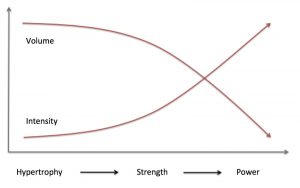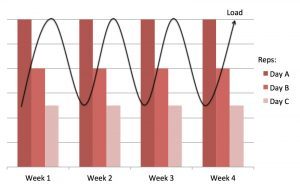When designing programs to enhance strength, there are many variables that you can (and should) manipulate to facilitate improvement. These can obviously include the sets and reps (volume), loads (intensity), frequency, and rest time (density). However, how we periodize these variables is also very important. Periodization is the systematic structuring of how you plan on manipulating these variables over time.
You probably know me well enough by now to know that I value systems and planning. One of our fundamental principles in program design at Champion is to “begin with the end in mind.” It drives me crazy to see programs written month-to-month without a goal in mind.
So it makes sense to develop a system of how you plan on periodizing your strength training, wether in the personal training, sports performance, or even rehabilitation setting.
While the strength and conditioning world has really embraced the concept of periodization, physical therapists are notorious for a complete lack of periodization. It’s not uncommon to perform “3 sets of 10” in the rehabilitation setting forever.
Perform a Google search for strength training periodization and you’ll find a sea of conflicting terminology that is likely to make you dizzy. Linear periodization, reverse linear periodization, non-linear periodization, undulated periodization, conjugated periodization, concurrent periodization, and block periodization are some of the many types of periodization programs that you can find.
Unfortunately there is little consensus on terminology or definition, feeding the confusion for people looking to learn about periodization even more. Add to that the ability to essentially say anything you want on the internet without needing any scientific validity and you’ll find a dozen different “best” ways to get strong.
But the real question still remains – does strength training periodization even matter? And if so, what type of periodization is best?
Effect of Periodized Versus Non-periodized Programs on Strength
Since the rehabilitation setting does such as poor job at implementing periodization into programs when returning from injury, we should start by establishing the need for periodization.
Anytime I have a research question in regard to Strength and Conditioning, I head over to Chris Beardsley and Bret Contreras’ website Strength and Conditioning Research. Chris has an excellent article on our current scientific understanding on strength training.
The article reviewed 7 studies comparing periodized and non-periodized programs on strength in untrained individuals. Of these studies, 4 reported significant benefits of periodization over no periodization.
Similarly, there were 7 studies comparing periodized and non-periodized program on strength in trained individuals. Of these 7 studies, 4 reported significant benefits of periodization and the remainder reported no differences. Using periodization may therefore have a beneficial effect on strength gains in both the trained and untrained population.
I wouldn’t say the research is overwhelming, but leans towards at least some form of periodization being more effective than using no periodization at all. I think we would all anecdotally agree with this as well.
Effect of Linear Versus Non-Linear Periodization
Now that we have established we should use some form of periodization, the focus now shifts on determining what the best form of periodization may be to improve strength.
Lets simplify, and perhaps oversimplify, the forms of periodization for this conversation as either linear periodization or non-linear periodization.
Linear periodization refers to the slow decrease in reps and increase in load. For example a 4-phase program may look like this:
- Program 1 – 3 x 12 with a light load
- Program 2 – 3 x 8 with a moderate load
- Program 3 – 4 x 5 with a moderate to heavy load
- Program 4 – 5 x 3 with a heavy load
As the reps go down, the weight goes up. This has been the most classic form of periodization used for the last several decades.
Antagonists to the linear periodization model often point out that the benefits seen early in the program in regard to strength and hypertrophy are not maintained throughout the program as the focus continuously shifts from program to program.
This has lead to several variations of non-linear periodization, including one of the most common, undulated periodization. Undulated periodization involves continuously shift the focus of the program on either a daily or weekly cycle.
A weekly undulated periodization program may look like this:
- Week 1 – 2×15
- Week 2 – 3×8
- Week 3 – 5×5
While a daily undulated periodization program may look like this:
- Monday – 2×15
- Wednesday 3×8
- Friday 5×5
While many have stated that undulated periodization is more beneficial at eliciting strength gains, does the research agree?
A recent meta-analysis was publish in the Journal of Strength and Conditioning Research. They reviewed hundreds of articles and ultimately select 17 that met all their strict criteria for analysis.
Of these 17 articles, here are a few bits of information:
- 12 compared linear periodization to daily undulating periodization. 3 compared linear to weekly undulating. 1 study compared all 3.
- 7 studies were on untrained people (<1 year experience), 10 on trained (> 1 year), and no studies included advanced trainees (>5 years).
- 16 out of 17 studies reported significant increase in strength in both linear and undulated periodization. 12 studies found no difference between the two periodization models. 3 found undulating better than linear and 2 found the opposite.
The overall meta-analysis also agree and the article concluded that there is no difference in strength gains between linear and undulated periodization.
However, when analyzing trained individuals, people that had previous experience with linear periodization had an improvement in strength when switching to undulated periodization. There was no difference between the linear or undulated periodization in untrained individuals.
Based on this it appears that as your training age increases, you may need to change your training stimulus to maximize your gains. However, linear periodization will work fine in new trainees.
Realize that the majority of articles you read on the internet are geared towards the very small percentage of people that fit into the advanced trainee grouping, when in reality, this is not what 95% of us see on a regular basis, especially in the rehabilitation and general population personal training worlds. Sure, advanced periodization programs are needed to get from 500 lbs to 600 lbs on a lift, but probably not as much from getting from 100 lbs to 200 lbs.
Linear periodization offers a great way to introduce and teach movement patterns with a lower load and higher rep scheme, then as the movement skill is perfected, the load can safely increase.
Periodization for Strength Training and Rehabilitation
Because the topic of periodization is so large, important, and so often neglected in the rehab and personal training setting, I have a past Inner Circle Webinar on Periodization for Strength Training and Rehabilitation. In this webinar, I am going to discuss the above concepts in much more detail and show you how we periodize some of our programs for healthy people and those coming back from injury in the physical therapy setting.
- Inner Circle members click here to access the webinar
- Learn how to access this webinar and much more in my online Inner Circle Mentorship program







